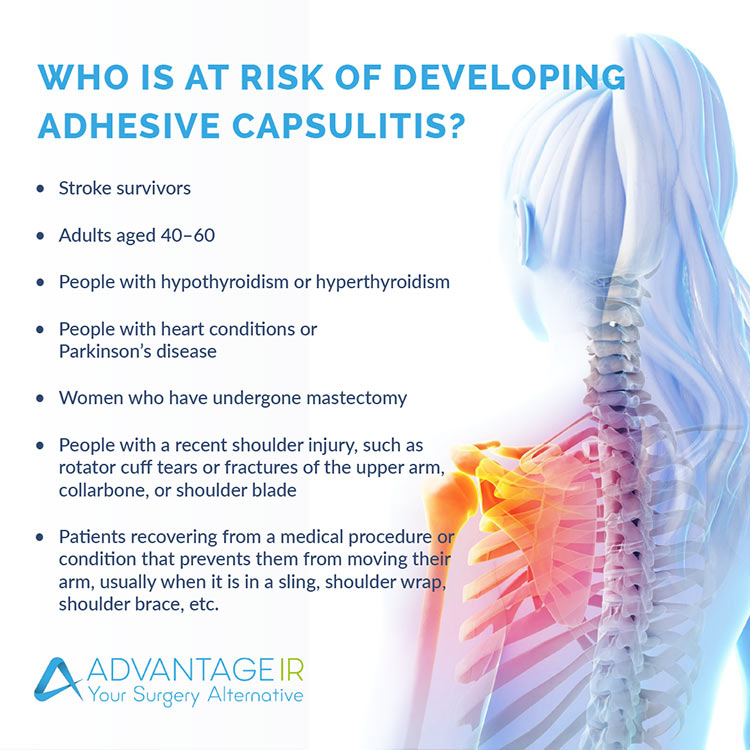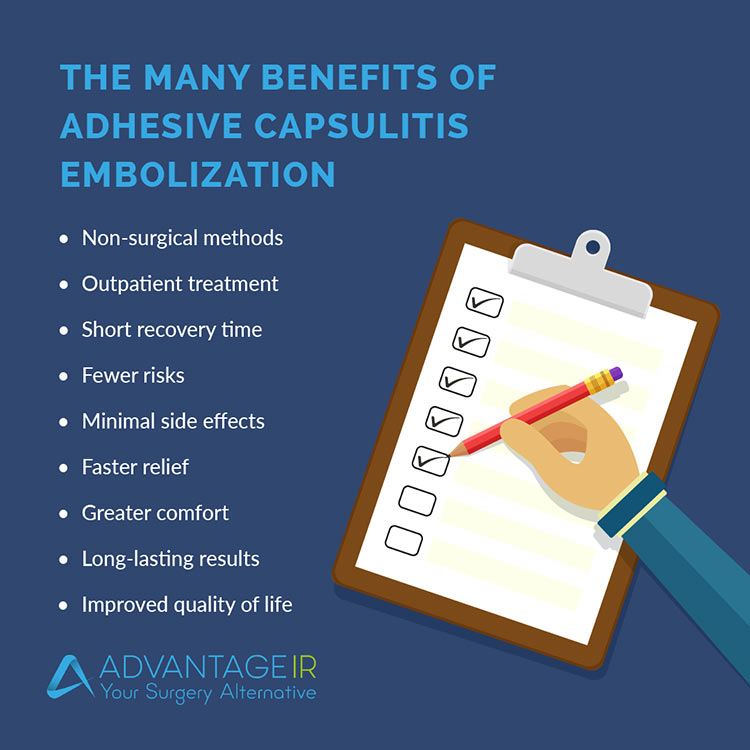Adhesive Capsulitis Embolization: An Alternative Treatment for Frozen Shoulder
ACE is a minimally invasive alternative treatment for frozen shoulder that has already shown excellent results

Adhesive capsulitis (AC) or frozen shoulder syndrome can cause significant discomfort and pain, limiting the patient’s range of mobility and decreasing their quality of life.
Unfortunately, the treatment options are still somewhat limited. People with this condition are usually prescribed physical therapy followed by a course of anti-inflammatory medications. These often produce mixed results and far-from-optimal health outcomes.
However, many patients do not know that they can now try a minimally invasive alternative treatment for frozen shoulder called adhesive capsulitis embolization (ACE). This procedure has already shown excellent results in successfully relieving capsulitis shoulder pain.
What is Frozen Shoulder Syndrome?
Frozen shoulder, formally known as adhesive capsulitis, is an inflammatory process characterized by joint pain, stiffness, and limited mobility in the shoulder.
Adhesive capsulitis normally occurs when the shoulder joint capsule – the connective tissue surrounding the joint – becomes stiff, thick, and inflamed. The joint capsule contains ligaments that connect the shoulder socket to the upper arm bone and keep the joint firmly in place. Most of the pain associated with adhesive capsulitis is caused by inflammation in the joint capsule.
The condition is called frozen shoulder because patients tend to use their shoulder less and less as the pain increases over time.
Unfortunately, the lack of movement causes the joint capsule to become progressively thicker and tighter, making the shoulder even more painful and difficult to move. Eventually, the shoulder ends up “frozen” in its place.
Who is at Risk of Developing Adhesive Capsulitis?
Frozen shoulder syndrome is a relatively common orthopedic condition. The prevalence in the general population is around 5% but increases up to 20% in people with diabetes. Other demographics that may be at a higher risk of developing AC include:
- Stroke survivors
- Adults aged 40–60
- People with hypothyroidism or hyperthyroidism
- People with heart conditions or Parkinson’s disease
- Women who have undergone mastectomy
- People with a recent shoulder injury, such as rotator cuff tears or fractures of the upper arm, collarbone, or shoulder blade
- Patients recovering from a medical procedure or condition that prevents them from moving their arm, usually when it is in a sling, shoulder wrap, shoulder brace, etc.

Signs and Symptoms of Frozen Shoulder
The most obvious sign of AC is pain in the shoulder joint. Most people report that the pain worsens at night and may even disrupt their sleep. Other symptoms include stiffness and an increasingly limited range of motion.
In most cases, the symptoms begin gradually, get worse over time, and then resolve – on their own or with treatment – in one to three years.
It is also possible to get frozen shoulder more than once. However, AC rarely recurs in the same joint: most people develop the condition in the other shoulder.
Frozen Shoulder Stages: How the Condition Progresses
Adhesive capsulitis typically develops incrementally and in three stages. Each stage can last several months. That means it is essential for patients and their healthcare providers to monitor any recurring or persistent shoulder pain from early on, even if it does not look like adhesive capsulitis at first.
The three stages of frozen shoulder syndrome are:
1. The Freezing Stage
During this early stage, even the slightest movement of the shoulder causes pain, and its range of motion starts to become limited.
2. The Frozen Stage
Pain may diminish during this time. However, the shoulder becomes stiffer, and moving it becomes more challenging.
3. The Thawing Stage
Signs that a frozen shoulder is starting to thaw include diminishing pain and stiffness. The range of motion in the joint may also begin to gradually improve.
How is Frozen Shoulder Diagnosed?
To diagnose a frozen shoulder, a doctor will first discuss the patient’s symptoms and go over their medical history.
This is followed by a physical exam of the arms and shoulders. The doctor will move the shoulder in all directions to assess the passive range of motion and check if the movement is causing any pain.
Next, the doctor will have the patient move their shoulder on their own to evaluate their active range of motion.
Ultimately, only an MRI of the shoulder can demonstrate inflammation in key regions of the joint and confirm the diagnosis of adhesive capsulitis.
How to Treat Frozen Shoulder: The Conventional Approaches
The standard frozen shoulder treatment protocol typically involves a combination of:
- Applying heat and ice to the affected area, which can help reduce the pain and swelling.
- Physical therapy, including gentle stretching and range-of-motion exercises.
- Non-steroidal anti-inflammatory drugs (NSAIDs), which may help reduce inflammation.
- Corticosteroids,a broad spectrum of drugs that decrease inflammation in the body and help reduce immune system activity.
- Numbing medicationsthat are usually injected directly into the joint capsule to relieve shoulder pain.
- Arthroscopic surgery, which is only prescribed in a small percentage of the most severe cases. These are typically patients with refractory pain or pain that cannot be controlled with less invasive means. If the surgery goes well, it can help loosen the joint capsule, allowing it to move more freely.
The Potential of Adhesive Capsulitis Embolization as an Alternative Frozen Shoulder Treatment
In recent years, ACE has been used with great success in treating frozen shoulder syndrome. Both clinical studies and real-world data indicate the procedure can deliver long-lasting, highly effective pain relief and improve joint stiffness and range of mobility.
What is Adhesive Capsulitis Embolization?
Adhesive capsulitis embolization is an alternative treatment for frozen shoulder syndrome.
The procedure is performed by an interventional radiologist – a doctor specializing in treating vascular issues using minimally invasive methods. One such method is embolization, which is used to block abnormal vascular channels or individual blood vessels. This causes the inflammation to subside, resulting in reduced pain and stiffness in the joint.
When performing adhesive capsulitis embolization, an interventional radiologist will use a small needle to make a puncture in the arm. They will then position a catheter into the blood vessels supplying the frozen shoulder joint. Typically, the doctor will also use X-ray guidance to ensure they are accessing the right blood vessels.
Once the catheter is in position, the radiologist will start releasing microscopic particles called microspheres into the abnormal vascular channels within the inflamed joint capsule. This blocks blood flow to the area, resulting in reduced inflammation.
The Many Benefits of Adhesive Capsulitis Embolization
ACE has several benefits over conventional treatments for frozen shoulder. These include:
- Non-surgical methods.ACE is minimally invasive. There are no cuts or incisions: all that is required is a tiny puncture in the skin. This makes the procedure much easier for patients and doctors alike.
- Outpatient treatment. ACE does not require a hospital stay.
- Short recovery time. Since the procedure is not invasive, patients can expect a much faster recovery and minimal downtime compared to conventional frozen shoulder surgery. Most people recover in just a couple of days.
- Fewer risks. Non-invasive procedures are associated with fewer risks of complications and bleeding both during and after the treatment.
- Minimal side effects.Possible adverse effects include bruising and soreness at the puncture site. These typically subside on their own in a few days.
- Faster relief. Unlike anti-inflammatory drugs and physical therapy, ACE directly targets the cause of the problem – the abnormal blood vessels. As a result, the procedure is more effective than standard non-surgical treatments and can provide faster relief to patients.
- Greater Recovery from embolization is not only faster but also less painful than after arthroscopic surgery. There are no stitches to remove or an incision to heal.
- Long-lasting results. Most patients experience dramatic and long-lasting pain relief within just a few days after their ACE procedure.
- Improved quality of life. Peoplewho undergo capsulitis embolization usually report a significant reduction in the use of pain medications and a significant increase in joint function scores. Such improvements can be expected from just one treatment.

Frozen Shoulder Syndrome FAQs
Scroll down to read the answers to some frequently asked questions about frozen shoulder syndrome.
Can You Stop Frozen Shoulder from Progressing?
In some cases, stretching, gentle range-of-motion exercises, and using your shoulder more may help prevent frozen shoulder after an injury or post-surgery. If you are already experiencing symptoms, the condition may go away on its own if it enters into the thawing phase or with treatment.
However, keep in mind that no two bodies are alike, and your condition may or may not respond to certain treatment types. In addition, scientists still do not know what triggers some cases of adhesive capsulitis, and it may not be possible to avoid these.
In any case, however, be patient and follow medical advice. Most cases of frozen shoulder often improve over time.
Will Frozen Shoulder Heal Without Physical Therapy?
It is possible, but it is not guaranteed. The condition may clear on its own, after a course of medication, or with adhesive capsulitis embolization.
What Helps Inflammation in Frozen Shoulder?
NSAIDs, corticosteroids, and adhesive capsulitis embolization can all reduce inflammation to varying degrees. It may also help to follow a frozen shoulder diet high in anti-inflammatory foods like fruit, vegetables, nuts, seeds, and fatty fish.
What Happens if a Frozen Shoulder is Not Treated?
Some cases may get better on their own. Others may worsen over time. However, nearly all patients experience a reduction in their symptoms in the long term.
What are the Best Supplements for Frozen Shoulder?
Some over-the-counter supplements like turmeric, Omega-3 fatty acids, and glucosamine and chondroitin may help relieve joint pain and reduce inflammation. They also have additional benefits for your overall health and may have fewer side effects than prescription medications.
Is It Okay to Massage a Frozen Shoulder?
Massage and physical therapy are recommended in nearly all cases of frozen shoulder and can help reduce your symptoms. However, it is important to have the massage performed by a qualified and experienced professional. You should not attempt to administer the massage yourself as that may further aggravate the affected area.
What is the Best Frozen Shoulder Treatment?
Conventional treatments for frozen shoulder syndrome include physical therapy, NSAIDs, corticosteroids, and, in the most extreme cases, arthroscopic surgery. While these may help some people, they are typically less effective than adhesive capsulitis embolization.
ACE is minimally invasive, has fewer risks and unwanted side effects, and is associated with faster recovery times. Patients who undergo ACE also experience greater comfort both during and after the treatment and enjoy quick relief, long-lasting results, and improved quality of life.
How Can I Cure a Frozen Shoulder Quickly?
In most cases, you cannot. Once the symptoms are underway, a frozen shoulder will typically take a year or more to get better. What you can do, however, is take steps to prevent the condition from developing in the first place by stretching, doing gentle exercise, and keeping a healthy diet.
Adhesive Capsulitis Embolization as an Alternative Frozen Shoulder Treatment: Final Thoughts
Adhesive capsulitis can cause significant pain, discomfort, and reduced enjoyment of life. Fortunately, a potentially more effective frozen shoulder treatment – adhesive capsulitis embolization – is now available.
Schedule an adhesive capsulitis embolization consultation today.
